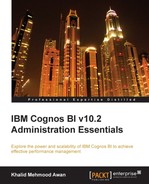A multiple-tenant environment is another new feature of Cognos BI Version 10.2 has.
After the introduction of cloud computing, one cloud service provider had to deal with multiple customers or organizations at a time. A feature was also added in Cognos to support multiple customers or organizations on the same (single) deployment.
By using the multiple-tenant feature for Cognos, organizations can only see their own data. Data for other organizations running on the same deployment is invisible to each of the other organizations. This is an efficient use of resources and money. Existing authentication providers can be used to manage users and groups, resulting in no additional administration tasks. Cognos also supports sharing of content between two tenants (organizations or customers) by declaring them public and setting suitable access and tenancy permissions.
To configure multi-tenancy, there are two steps:
The IBM Cognos configuration needs to be modified before using the Cognos multi-tenancy feature. The following methods can help identify tenancy information:
- Using hierarchies
- Using object properties
- Using custom code (when the first two methods fail)
Setting advanced authentication properties on all Content Manager servers enables multi-tenancy and removing all advanced authentication properties disables it.
Since multiple tenants can be stored in the same content store, a tenant ID is associated with each object that is created. Cognos system administrators have full access to tenant information. Tenant-related administrative tasks are performed by Cognos system administrators. This is done from the IBM Cognos BI Configuration window.
